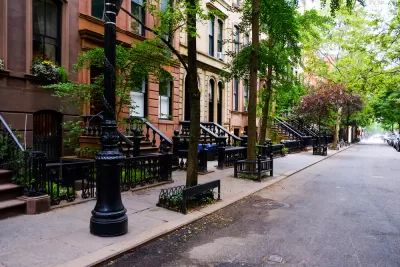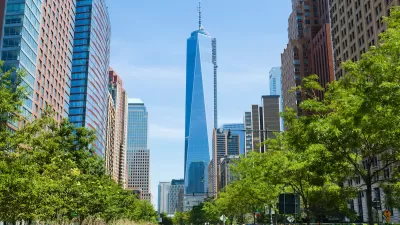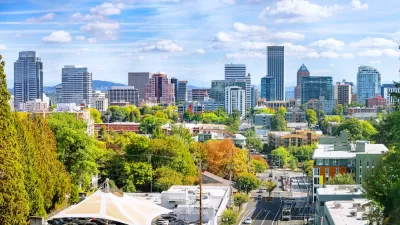A case study provided by the MillionTreesNYC program offers insight into complicated territorial boundaries that can challenge urban greening projects.

An article by Nicole Peterson digs into the results of a recent paper titled "Public Reactions to New Street Tree Planting," examining public relations efforts for the MillionTreesNYC program.
According to Peterson, the key lesson for landscape architects to gain from the study is: "we are often under the impression that because we love urban trees and seeing new trees planted, that everyone around us will love these plantings as well. Some city dwellers do in fact welcome trees with great excitement, but others may see the trees as an intrusion of their private space or territory."
For non-landscape architects and landscape architects alike, the important lesson might also be a central concept employed by Peterson: the sidewalk as a "gray zone" that blurs the line between public and private interests.
According to Peterson, "while the city has legal authority over the sidewalk, responsibility for this zone also lies with citizens. This 'Sidewalk Grey Zone' is one reason the public can have negative reactions to tree plantings. In this example, The City of New York owns the space between the curb and the property line, but the home or business owner is responsible for the maintenance and upkeep of the sidewalk."
As for the findings reported by the paper: the study's researchers "investigated the content of letters, emails, and transcriptions of calls from 311 received by the Parks Department’s Central Forestry and Horticulture Division between 2007 and 2009," according to Peterson's explanation.
"Placement objections" were the largest primary category of complaint (33%), according to Peterson. "Of those complaints, most people were concerned about the disturbance of utility lines."
The evidence of the challenging nature of the sidewalk gray zone, however, was probably most apparent in the category of "policy objections." Of those, 57% "were a general refusal, meaning the resident did not want a tree in front of their property." According to Peterson, "[t]his reaction assumes dissatisfaction with the planting policies and the city exercising its authority over right of way areas. It also indicates how the planting of street trees can evoke issues of territoriality and control."
FULL STORY: The Sidewalk Gray Zone

Planetizen Federal Action Tracker
A weekly monitor of how Trump’s orders and actions are impacting planners and planning in America.

Congressman Proposes Bill to Rename DC Metro “Trump Train”
The Make Autorail Great Again Act would withhold federal funding to the system until the Washington Metropolitan Area Transit Authority (WMATA), rebrands as the Washington Metropolitan Authority for Greater Access (WMAGA).

DARTSpace Platform Streamlines Dallas TOD Application Process
The Dallas transit agency hopes a shorter permitting timeline will boost transit-oriented development around rail stations.

Renters Now Outnumber Homeowners in Over 200 US Suburbs
High housing costs in city centers and the new-found flexibility offered by remote work are pushing more renters to suburban areas.

The Tiny, Adorable $7,000 Car Turning Japan Onto EVs
The single seat Mibot charges from a regular plug as quickly as an iPad, and is about half the price of an average EV.

Supreme Court Ruling in Pipeline Case Guts Federal Environmental Law
The decision limits the scope of a federal law that mandates extensive environmental impact reviews of energy, infrastructure, and transportation projects.
Urban Design for Planners 1: Software Tools
This six-course series explores essential urban design concepts using open source software and equips planners with the tools they need to participate fully in the urban design process.
Planning for Universal Design
Learn the tools for implementing Universal Design in planning regulations.
Municipality of Princeton
Roanoke Valley-Alleghany Regional Commission
City of Mt Shasta
City of Camden Redevelopment Agency
City of Astoria
Transportation Research & Education Center (TREC) at Portland State University
US High Speed Rail Association
City of Camden Redevelopment Agency
Municipality of Princeton (NJ)




























